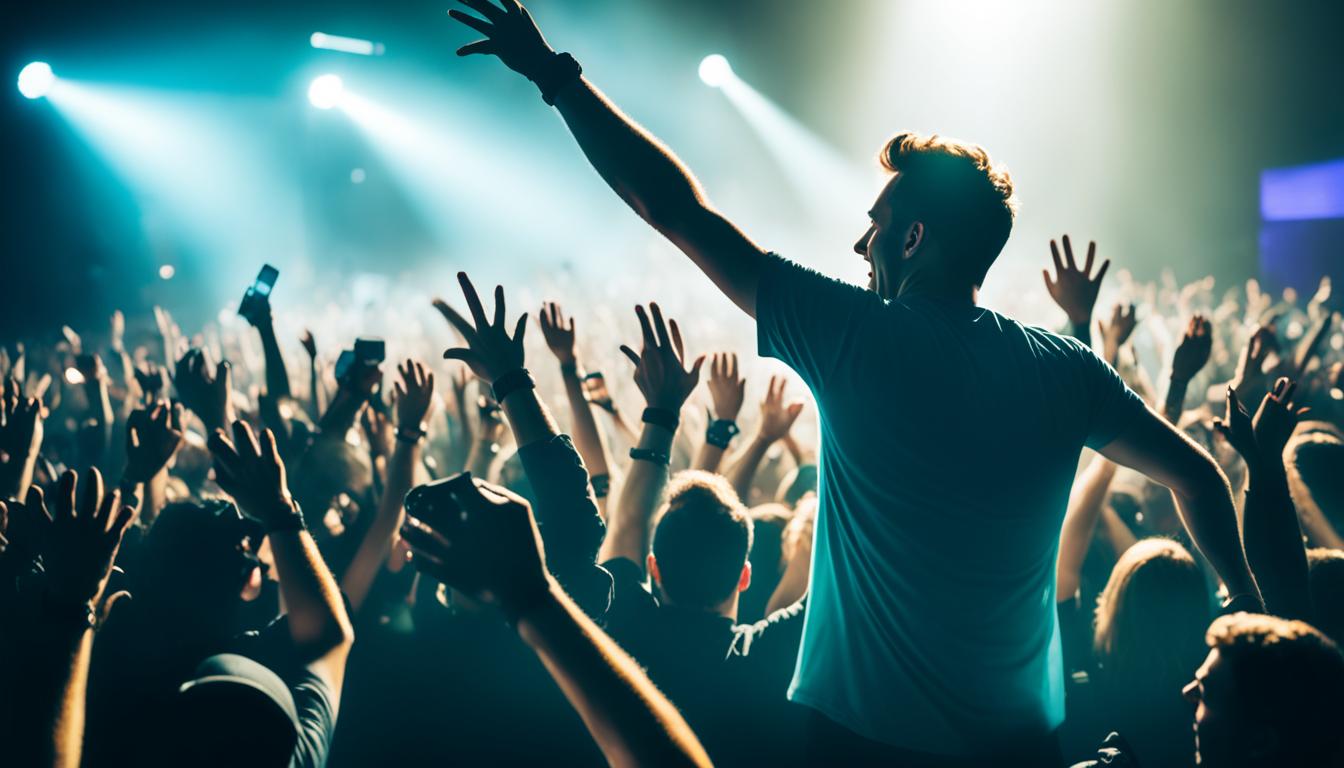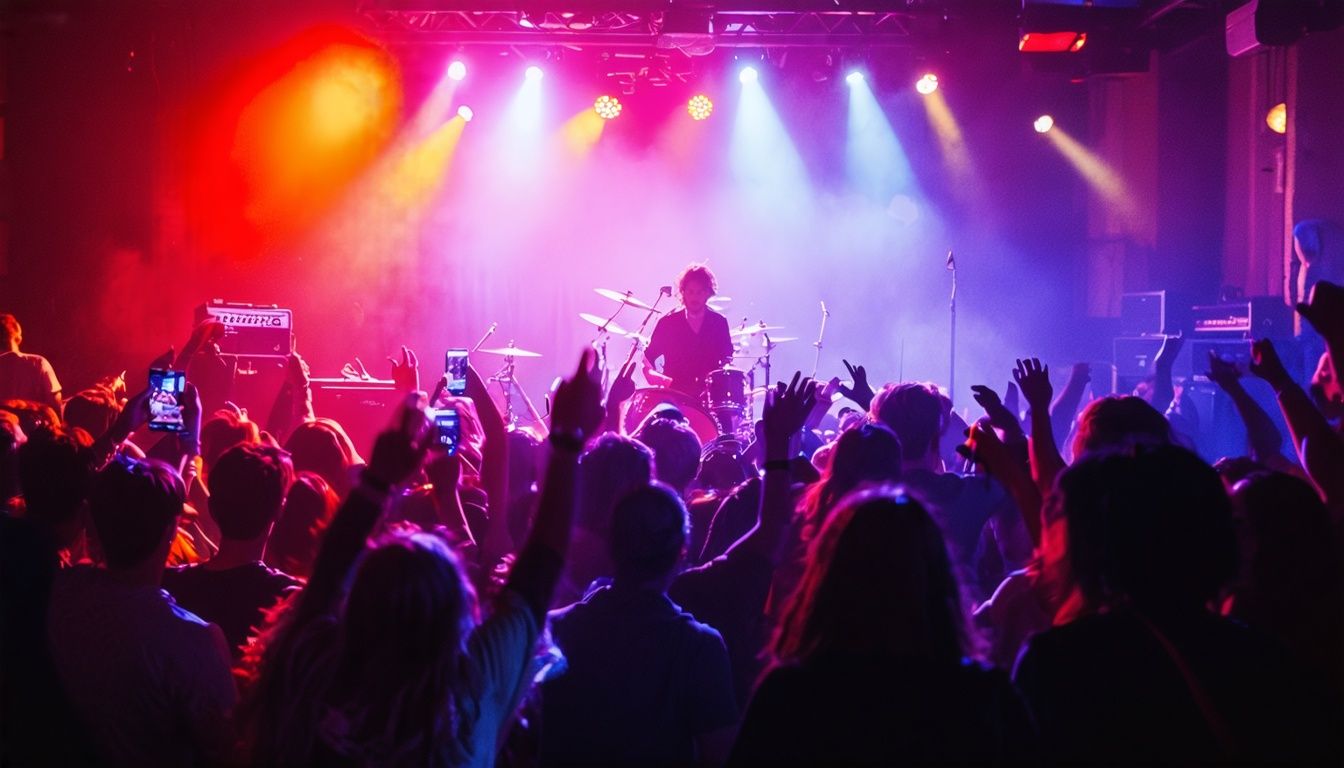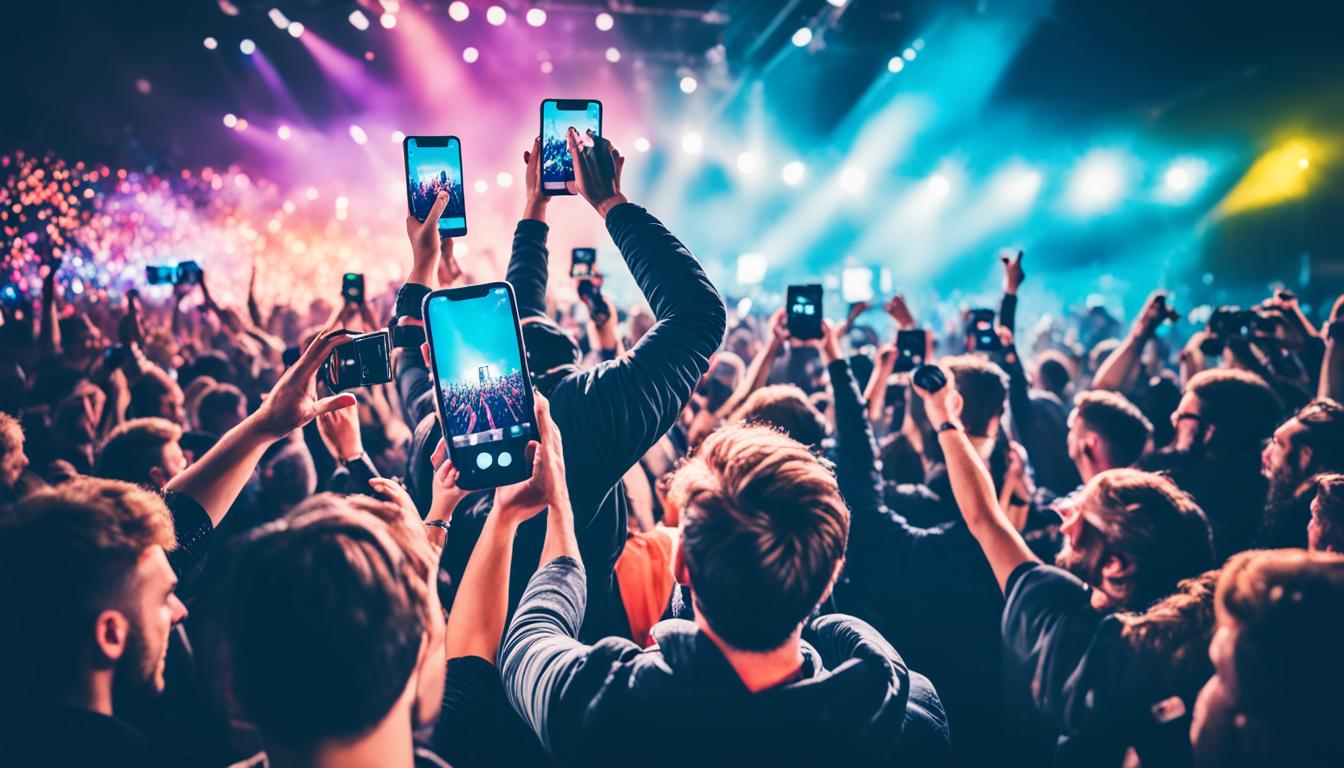Taking up concert photography is like entering a world filled with rhythm. When we point our cameras at the stage, we aim to do more than just take pictures. We want to capture moments that reflect the excitement of live music. For beginners, knowing the basics is crucial. These moments are not just pictures. They are records of live music’s spirit.
Every beat and note gives us a chance to share a story. With helpful tips, our photos can show the power and energy of the music and crowd. We’re ready to create photos that form a perfect visual symphony.
Key Takeaways
- Embrace the challenge of illuminating the dynamic spirit of live performances through your imagery.
- Develop a solid grasp of beginner concert photography essentials to craft your unique visual narrative.
- Employ music photography basics to adeptly navigate the rapid tempo of live shows.
- Study crucial concert photography tips to turn fleeting moments into timeless recollections.
- Understand that concert photography is not just about the images, but capturing the essence of the musical experience.
The Power of the Lens: Understanding Concert Photography
Concert photography is more than snapshots of performers. It captures the live music experience forever. A great concert photographer transports you into the moment. If a concert photo has ever given you chills, then you know its power.
Why Concert Photography Matters
Concert photos are precious to musicians and fans. They capture the music event’s soul. Photographers use special equipment to make these moments last. These photos let fans relive memories and help artists grow their reach. They’re key to preserving musical history.
History and Evolution of Music Photography
Music photography has changed a lot. It has moved from black-and-white film to vibrant digital images. The music photographer’s role has evolved too. They’re now storytellers with high-tech gear. They adapt to new editing techniques to make each photo emotion-filled.
Influential Concert Photographers and Their Impact
Some photographers have shaped concert photography. Their iconic shots are unforgettable. They’ve helped shape music culture’s visual language. Their editing skills turn photos into impactful statements. These moments live on forever.
Exploring this genre shows the skill and passion needed. Each shot combines light, shadow, and sound perfectly. We aim to capture history and celebrate music’s spirit through photography.
An Introduction to Concert Photography: Getting Started
Diving into concert photography is thrilling. It mixes passion, prep, and a readiness to learn. We’ve collected key techniques to help photographers capture live music’s dynamic spirit.
Getting a photo pass is critical for entering the music scene. It lets you into special areas, like the photo pit. This opportunity means you should quickly adjust to quick changes in lighting and performances.

An Introduction to Concert Photography is more than just camera settings. Mastering technical skills and having an artistic view is crucial. Consider this guide when shooting:
| Technical Aspect | Tip | Creative Consideration |
|---|---|---|
| Aperture | Use a wide aperture for a shallow depth of field. | Isolate subjects and create bokeh with stage lights. |
| Shutter Speed | Fast enough to freeze motion, typically 1/200 sec or faster. | Capture the peak action moments for dynamic imagery. |
| ISO | Balance your need for light with the desire to minimize noise. | Embrace the grain when needed to convey the concert’s raw atmosphere. |
It’s not only about camera settings, but storytelling too. Highlighting performers’ emotions or their connection with fans brings impactful moments to life.
Networking is vital. Connecting with artists, publicists, and other photographers leads to opportunities. Each event is a chance to grow, learn, and refine your skills. Every concert is a new stage to showcase your artistry.
We see the blend of technical and artistic elements in concert photography’s initial stages. Learning these skills positions us to immortalize live music’s magic.
Framing the Stage: Techniques and Composition
Concert photography is more than just taking pictures. It captures the live performance’s heart. Concert photography techniques and tips help us catch the intensity and passion of live music. These moments make the experience memorable.
Capturing Energy and Emotion
We aim to catch the vibrant energy and emotion on stage. It’s about the singer’s intensity or the guitarist’s solo. Concert photography techniques need patience and observation. This lets us freeze the raw emotion forever.

Composition Strategies for Dynamic Images
We need to create a compelling narrative with our shots. Using the rule of thirds, leading lines, and framing helps. These tips make the viewer’s eye go into the photo. They add depth to the story we tell.
Tips for Shooting in Low Light and Challenging Environments
Concerts often have low light, which is hard for photographers. Using a high ISO and fast lenses can overcome this. Knowing how shutter speed, aperture, and ISO work together is key. This is crucial to master concert photography in these settings.
| Challenge | Concert Photography Tip | Recommended Technique |
|---|---|---|
| Low Light | Use a fast lens | Increase ISO with care |
| Moving Subjects | Anticipate action | Use a faster shutter speed |
| Busy Backgrounds | Isolate the subject | Wide aperture for shallow depth of field |
| Colorful Lighting | Balance the white settings | Adjust white balance to suit the dominant light source |
As concert photographers, we aim to feel, understand the artist, and capture that in a still image. With these tips and techniques, we’re ready to seek the perfect shot. It’s about capturing the essence of the performance and the artist’s heart.
Essential Gear for Concert Photography
In the realm of concert photography, knowing the right concert photography equipment is crucial. It’s as important as learning the music photography basics. This knowledge helps us capture the dynamic essence of live shows. It lets us take stunning photos that reflect the music scene’s energy.
The camera body is the core of our equipment. It’s not just about having lots of megapixels. The main thing is how well it works in low light. Cameras that do well at high ISOs let us take clear photos in dark settings without using a flash. This keeps the show and audience undisturbed.
- Fast glass: A wide-aperture lens, like f/2.8 or wider, is crucial. It lets in more light, helping in the dark concert settings.
- Zoom lens: A good zoom lens offers flexibility. It allows us to capture close-ups of performers from a distance.
- Wide-angle lens: Essential for big crowd shots or capturing the whole stage. A wide-angle lens gets it all.
This gear is just the beginning for concert photography. As we get more into it, we might add more specialized tools. But starting with a strong camera and a few good lenses is key. Knowing how to catch the right moments and understanding concerts is what makes our photos stand out.
By getting to know our equipment and creating our own style, we’ll become more recognized in concert photography. With every amazing photo, our presence in this vibrant field grows.
Behind the Scenes: Access, Etiquette, and Networking
To get into concert photography, you need the right credentials. It’s important for us, the newbies, to understand access rules. We must learn the unspoken rules of photo pits and backstage.
Many tips don’t stress the importance of etiquette enough. However, we’ve realized it’s crucial for professionalism. Being respectful is as key as your camera. It’s not just about amazing shots, but also about being trusted by venues and artists.
Building good relationships with bands and their publicists is important. Networking is key to moving forward in concert photography. Here, we share some vital tips to help you succeed in the backstage world and grow your career:
- Always introduce yourself to event organizers and photographers, and have your business card ready.
- Respect the three-song rule, which allows shooting during the first three songs.
- Don’t be intrusive; the show is for the artist, not us. Be respectful in the pit.
- Communicate gratitude by sending a thank-you note after the event.
Below is a table that highlights key concert photography etiquette:
| Aspect | Why It Matters | How to Execute |
|---|---|---|
| Access | Defines shooting boundaries | Get the right passes and follow rules |
| Behavior | Keeps you professional | Be discreet, polite, and mindful of others |
| Networking | Helps open new doors | Talk to industry people and stay in touch |
| Fulfilling Requests | Builds trust and rapport | Send bands and publicists images quickly |
Whether you’re starting or diving deeper into concert photography, learning the ropes is key. Mastering both the technical skills and the rules of live concerts will shape your success. Balancing between respecting the artist’s space and getting good shots is our biggest challenge.
Conclusion
Starting concert photography lets us see the true essence of live music. It’s more than taking pictures. It’s about catching moments full of life’s rhythm. As discussed in “An Introduction to Concert Photography,” it’s challenging but very rewarding. Behind every shot, there’s a story waiting to be told, lasting well beyond the last song.
Improving our skills with solid concert photography tips is crucial. It’s not just about the shot itself. It’s about the play of shadows and lights during editing. This is when our photos truly speak. Each edit brings out the trapped emotions and colors from our shots.
We join musicians and fans in documenting history through our lenses. Thus, creating a visual legacy that breaks walls and unites hearts. With the right skills, gear, and technique, we capture live concerts’ raw energy. Let’s keep perfecting our art, sharing our views, and telling stories through concert photography. Let’s keep the spirit of live music bright for everyone.
FAQ
What are some essential concert photography tips for beginners?
Beginners should get ready for the fast pace of concert photography. It’s vital to know your camera settings for low light. Positioning and anticipation can greatly improve your shots.
Use a fast lens and work on your timing. This will help you get better live music photos.
How do I choose the right concert photography equipment?
Choosing the right gear is key. You want cameras that do well in low light and fast lenses. Bring prime and zoom lenses for quality and flexibility. Always have extra batteries and memory cards.
How do I capture the energy and emotion in my concert photographs?
Focus on performers’ emotions and their interaction with fans to get the concert’s feel. Use fast shutter speeds to stop motion and slow ones for movement. Knowing the band helps anticipate these moments.
What are some effective techniques for shooting concerts in low light and challenging environments?
Master your camera’s ISO settings and use lenses with large apertures. Try different shutter speeds. Use the stage lights to make your images pop.
Why does concert photography matter?
It captures the live performance’s energy and saves it visually. Fans can relive concerts and bands get great promotional material. It strengthens the connection between bands and their fans.
How has music photography evolved over time?
Advances from film to digital and changing social contexts have shaped music photography. It’s more immediate and diverse now, giving a fuller picture of live music.
Can you discuss the impact of influential concert photographers on the industry?
Influential photographers capture iconic moments and set visual standards. Their work affects how we see musicians and can be part of a band’s legacy.
How do I handle concert photo editing to enhance my images?
Edit your photos to adjust exposure, contrast, and color. Keep the photo’s integrity but highlight what shows the concert’s vibe. Adobe Lightroom is recommended for editing.
What is the best way to gain access and understand the etiquette in the photo pit at concerts?
To get into the photo pit, you need a pass or media accreditation. Network with event organizers or bands’ PR teams. Be respectful and professional in the pit to ensure you get invited back.
What networking strategies are important for a beginner in concert photography?
Attend events, join groups, and connect with bands and venues. Share your work online and use social media. Have business cards ready for networking opportunities.
How do I get started with an introduction to concert photography?
Start by going to local gigs and practicing. Learn camera basics and look at pros’ work. Reach out to local bands or venues to photograph their shows. Don’t be shy to experiment.



